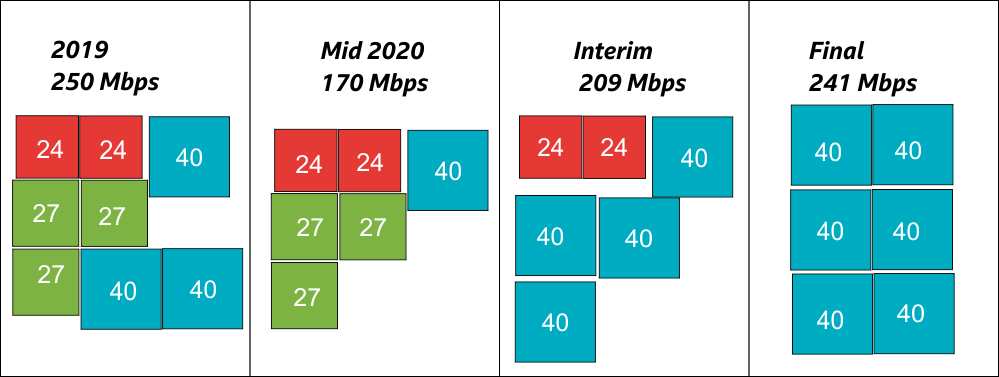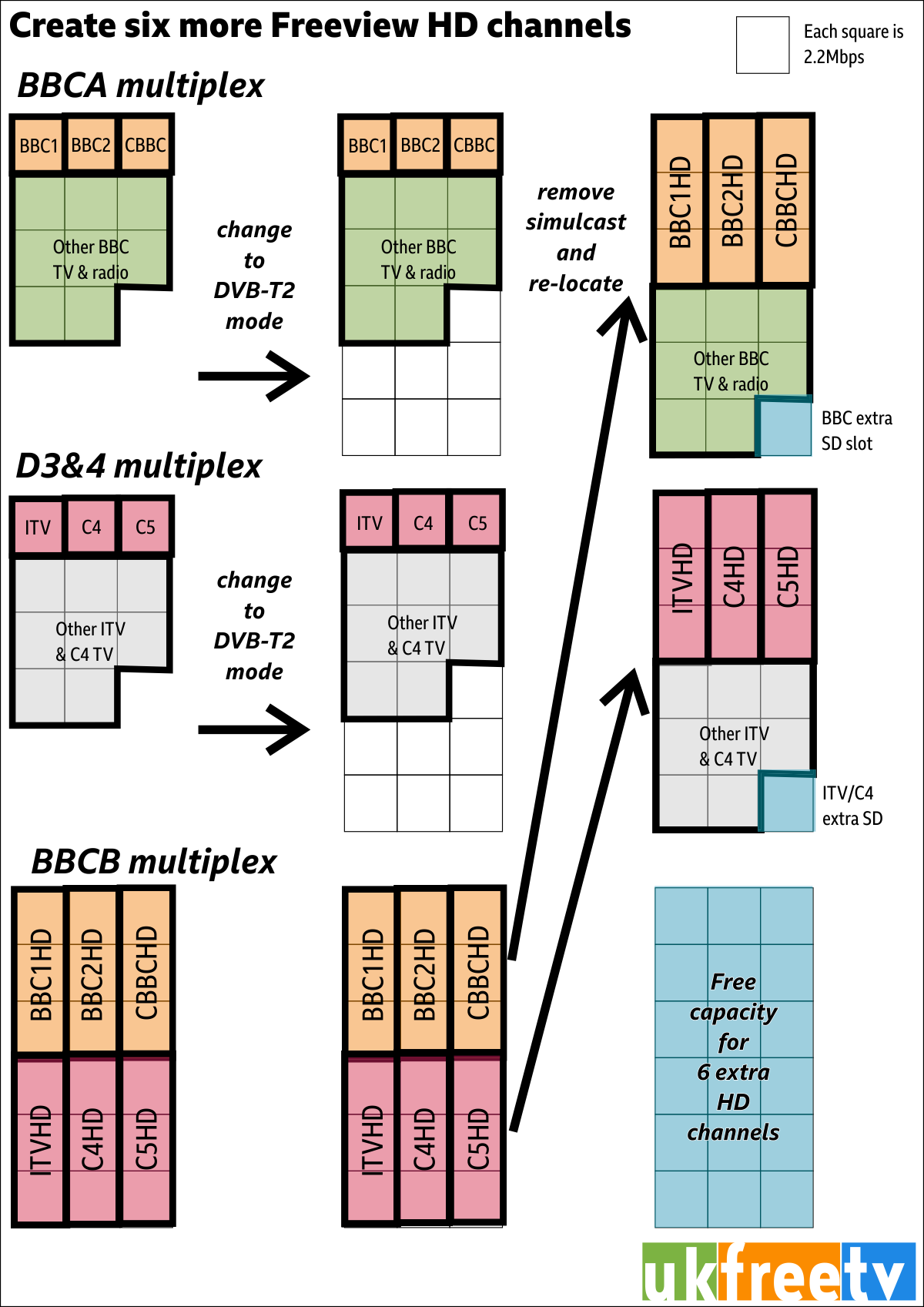Rebuilding Freeview High Definition from 2019 onwards

As Freeview High Definition users in Cornwall already know, the number of TV channels being broadcast in the UK will be cut back in mid-2020 to make way for the fifth generation of mobile phone data services.
This is because the number of multiplexes being broadcast will be cut back to the original six. The extra two were provided as a “interim service”. A Freeview multiplex is a single broadcast of binary data that occupies a 8MHz frequency range. In the UK each of these can carry 24.1, 27.1 or 40.2Mbps or of data.
Because older TV sets and set-top boxes can only work with 24.1 Mbps, it is only possible for the owners of the multiplexes to use the higher capacity modes when every home has switched to Freeview HD capable equipment. This equipment is marked with “DVB-T2”.
As illustrated, the total bitrate (in a home that can receive all the multiplexes) will change over time.

Meet the multiplexes
Not all the multiplexes are the same:
- only three are broadcast to the whole of the UK;
- a different three are broadcast in the better DVB-T2 mode;
- legally, only BBC channels may appear on BBCA
- also, legally, only public service broadcast channels (ITV, C4, C5) can appear on D3&4
- The HD mode multiplexes have more bits and use a more video efficient encoding system (MPEG-4)
- The current license to broadcast have different end-dates
This can be summaries in this table.
|
Multiplex name |
Expires |
HD mode? |
Coverage |
Mode |
Bitrate today |
||
|
com7 |
21 June 2020 |
Yes |
76% |
6 |
40.2 |
||
|
com8 |
21 June 2020 |
Yes |
76% |
6 |
40.2 |
||
|
D3&4 |
15 November 2022 |
No |
100% |
3 |
24.1 |
||
|
ARQA |
15 November 2026 |
No |
90% |
8 |
27.1 |
||
|
ARQB |
15 November 2026 |
No |
90% |
8 |
27.1 |
||
|
SDN |
15 November 2026 |
No |
90% |
8 |
27.1 |
||
|
BBCB |
16 November 2026 |
Yes |
100% |
6 |
40.2 |
||
|
BBCA |
31 December 2027 |
No |
100% |
3 |
24.1 |
Freeview requires about 2.2Mbps for a standard definition channels and three times that for a high definition one (6.7Mbps).
The Freeview HD EPG problem
One problem for people with Freeview HD receivers will note is that HD channels are grouped together in the program guide, rather than appear as replacements for the standard definition channels as viewers expect. This is because the six channels on the BBCB multiplex (BBC One, BBC Two, CBBC, ITV, Channel 4 and Channel 5) can only be seen on newer boxes, making channel number replacement impossible without breaking the oldest Freeview equipment.
Basically the UK-wide BBCA and D3&4 multiplexes can’t change mode until ALL homes can receive them.
The interim position
There is good news, however, for the SDN, ARQA and ARQB multiplexes. They can switch modes to the high definition whenever they feel that it is commercially practical. This might be at a lower level of Freeview HD box use, perhaps 80% or 90%.
By switching to DVB-T2 mode, each of them can increase their capacity from 27.1 to 40.2Mbps and take advantage of MPEG4.
.png)
So, of the 80Mbps lost when com7 and com8 close, half of that can be got back by SDN, ARQA and ARQB upgrading, which would be enough for an extra 6 full HD services.
The HD public service channels
This diagram explains what will happen to create space six more Freeview HD channels.

The gains for the BBC when everyone has a DVB-T2 receiver are larger. It will:
- No longer need half of the capacity on the BBCB multiplex (20.1Mbps) as it can move these channels to BBCA
- Gain 16.1 Mbps on BBCA due to the mode change;
- Gain 6.6 Mbps from not simulcasting three services in SD and HD
- Use the “gained 22.1Mbps” Be able to supply all the BBC television channels in HD to all UK homes
For the D3&4 multiplex, the gains are similar:
- No longer need the 20.1Mbps on BBCB, making it available for other UK-wide services.
- Gain 16.1 Mbps on D3&4 due to the mode change;
- Gain 6.6 Mbps from not simulcasting three services in SD and HD
- Be able to broadcast ITV, C4 and C5 in HD to all UK homes
I hope that's as clear as possible! Any qestions?
12:58 PM
What plans are there to improve the coverage of Free view in the Scottish Highlands. My caravan is located at Gairlochy and coverage is very poor
| link to this comment |
Denise: The official line is "Some viewers may also need to install a small filter at the back of their TV to prevent interference once new mobile services launch. " - Digital UK | 700MHz clearance
In theory, at least, 5G signals should be lower power than 4G. Because they use a large number of smaller cells to provide more (let's call them) connections, these have to be low power to prevent signal overloads in the very small cells.
In practice, the problem for most people with the previous set-up of 4G services was that the signals caused people's amplifiers to overload in certain circumstances.
In theory, at least, you should be able to remove your old "filter" once the clearance is complete. If you need a new one probably depends on if you end up with some channels broadcast at the "new top" of the Freeview transmission band.
| link to this comment |
Barrie Spink: There are no plans to extend Freeview beyond the current broadcast areas.
In the Scottish Highlands it is very hard to put up transmission masts that can be "seen" by domestic locations.
From the broadcaster's point of view, it's much cheaper to send the signals up to a satellite above the equator, than it is to build more relay stations on the ground.
It just isn't economic to serve small numbers of homes from ground-based transmitters when the Astra satellites can used instead.
| link to this comment |
John Martin: In fact, when they refer to "8k", it doesn't refer to the vertical resolution ("lines"), but the 7680 horizontal pixel count.
In old money "8k" would be 4320p ... compared with Feeview HD's 1080p.
Ultra HD, of course, is "4k" resolution (meaning 3840) which is 2160p. You can use UHD already with services like YouTube and Netflix.
| link to this comment |
2:41 PM
Hinckley
More equipment ending up in landfill because the goalposts have been moved again.
| link to this comment |
Ian's: mapI's Freeview map terrainI's terrain plot wavesI's frequency data I's Freeview Detailed Coverage
8:33 PM
The goalposts have always been shifting with freeview which is why, combined with the limited bandwidth, I stopped bothering with it. I watch cable TV as it has the highest bitrate and best quality. Satellite picture quality is a lot better than Freeview, but not as good as Cable TV, and it's susceptible to weather interference.
Looking at the bitrates presented here, Freeview HD is an absolute joke. On the face of it, 2 or 3 channels pre multiplex at about 12Mbps each channel would give quite a good HD picture.
I think that for those serious about the visual quality of what they watch a proper high-speed broadband distribution infrastructure may be the best option.
I find it interesting to consider that few people have seen what Standard Definition is REALLY capable of in terms of picture quality. More pixels does not mean a better quality picture.
| link to this comment |
9:05 PM
Bob:
Satellite is really only susceptible to weather effects if the dish being used is too small. Typically the 35cm dish used by many is just not capable of giving reliable reception, especially in western, midlands and northern parts of England, It is worse in Wales, Northern Ireland and Scotland.
I use a 55cm dish and never have any weather related problems in West Wiltshire.
| link to this comment |
7:35 PM
We live in a valley but only 20 miles from Crystal Palace transmitter. Our local Wooburn transmitter does not carry the stations we like to watch so we put up with a fluctuating signal from Crystal Palace. Last year we lost Mux 33/35 and as a result can no longer receive BBC4 HD. This is a station we have always watched regularly. My question is, when is it like;y that we will have BBC4 HD restored. I know we might be able to receive it now but this would mean changing our aerial to a wide band one. Since these are lower gain than the current Band A aerial we have, it is not an option to change as we might then be unable to receive some of the stations currently enjoyed, albeit with frequent signal dropouts. Help please.
| link to this comment |
11:19 PM
Keith: COM7 & COM8 have moved to UHF channels 55 & 56, where they will remain until they close in the next couple of years. These are well outside of the frequency range that your Group A aerial is designed to receive and there is nothing that will improve this. Your choice is to either fit a wideband aerial and accept that you won't get a strong signal or look at getting Freesat.
| link to this comment |
7:08 PM
Is it correct that Digital 3 and 4 (D3&4) expires in 2022?
That's only 3 years away for every one to get a new TV if they want to watch ITV, Channel 4 or Five.
As most or all relays can only get BBCA and D3&4 if they don't have a HD TV then they will lose all TV except the BBC channels.
| link to this comment |
